A Technological Approach to Support Extensive Livestock Management in the Portuguese Montado Ecosystem
Abstract
:1. Introduction
2. Materials and Methods
2.1. Site Description
2.2. Field Management
2.3. Soil Apparent Electrical Conductivity (ECa) and Topographic Measurements: Data Processing
2.4. Soil Sampling and Laboratory Reference Analysis
2.5. Pasture Sampling and Laboratory Reference Analysis
2.6. Evaluation of Pasture Floristic Composition
2.7. Vegetation Multispectral Measurements
2.8. Definition and Validation of Homogeneous Management Zones (HMZ)
2.9. Statistical Analysis of the Data
3. Results
3.1. Variability of Soil and Pasture Parameters
3.2. Maps of Homogeneous Management Zones (HMZ)
3.3. Pasture Floristic Composition (PFC) as Bio-Indicator of Field Management
3.4. Relationship between Pasture Quality Parameters and Indices Obtained by Remote Sensing
4. Discussion
4.1. Variability of Soil and Pasture Parameters
4.2. Homogeneous Management Zones (HMZ)
4.3. Pasture Floristic Composition (PFC) as Bio-Indicator of Field Management
4.4. Relationship between Pasture Quality Parameters and Indices Obtained by Remote Sensing
5. Conclusions
Author Contributions
Funding
Institutional Review Board Statement
Informed Consent Statement
Data Availability Statement
Conflicts of Interest
References
- Serrano, J.; Shahidian, S.; Marques da Silva, J.; Silva, L.L.; Sousa, A.; Baptista, F. Differential vineyard fertilizer management based on nutrient’s spatio-temporal variability. J. Soil Sci. Plant Nutr. 2017, 17, 46–61. [Google Scholar]
- Serrano, J.; Shahidian, S.; Marques da Silva, J.; Paixão, L.; Moral, F.; Carmona-Cabezas, R.; Garcia, S.; Palha, J.; Noéme, J. Mapping management zones based on soil apparent electrical conductivity and remote sensing for implementation of variable rate irrigation: Case study of Corn under a center pivot. Water 2020, 12, 3427. [Google Scholar] [CrossRef]
- Schellberg, J.; Hill, M.J.; Gerhards, R.; Rothmund, M.; Braun, M. Precision agriculture on grassland: Applications, perspectives and constraints. Eur. J. Agron. 2008, 29, 59–71. [Google Scholar]
- Serrano, J.; Shahidian, S.; Costa, F.; Carreira, E.; Pereira, A.; Carvalho, M. Can soil pH correction reduce the animal supplementation needs in the critical autumn period in Mediterranean Montado ecosystem? Agronomy 2021, 11, 514. [Google Scholar] [CrossRef]
- Yu, H.; Wang, L.; Wang, Z.; Ren, C.; Zhang, B. Using Landsat OLI and random forest to assess grassland degradation with aboveground net primary production and electrical conductivity data. Int. J. Geo-Inf. 2019, 8, 511. [Google Scholar]
- Pullanagari, R.; Yule, I.; Tuohy, M.; Hedley, M.; Dynes, R.; King, W. Proximal sensing of the seasonal variability of pasture nutritive value using multispectral radiometry. Grass Forage Sci. 2013, 68, 110–119. [Google Scholar]
- Georgi, C.; Spengler, D.; Itzerott, S.; Kleinschmit, B. Automatic delineation algorithm for site-specific management zones based on satellite remote sensing data. Precis. Agric. 2018, 19, 684–707. [Google Scholar]
- Costa, M.M.; Queiroz, D.M.; Pinto, F.A.C.; Reis, E.F.; Santos, N.T. Moisture content effect in the relationship between apparent electrical conductivity and soil attributes. Acta Sci. 2014, 36, 395–401. [Google Scholar] [CrossRef] [Green Version]
- Schenatto, K.; Souza, E.G.; Bazzi, C.L.; Gavioli, A.; Betzek, N.M.; Beneduzzi, H.M. Normalization of data for delineating management zones. Comput. Electron. Agric. 2017, 143, 238–248. [Google Scholar]
- Cicore, P.L.; Castro Franco, M.; Peralta, N.R.; Marques da Silva, J.R.; Costa, J.L. Relationship between soil apparent electrical conductivity and forage yield in temperate pastures according to nitrogen availability and growing season. Crop. Pasture Sci. 2019, 70, 908–916. [Google Scholar]
- Stepien, M.; Samborski, S.; Gozdowski, D.; Dobers, E.S.; Chormanski, J.; Szatylowicz, J. Assessment of soil texture class on agricultural fields using ECa, Amber NDVI, and topographic properties. J. Plant Nutr. Soil Sci. 2015, 178, 523–536. [Google Scholar]
- Serrano, J.; Shahidian, S.; Da Silva, J.M.; Paixão, L.; Calado, J.; De Carvalho, M. Integration of soil electrical conductivity and indices obtained through satellite imagery for differential management of pasture fertilization. AgriEngineering 2019, 1, 567–585. [Google Scholar] [CrossRef] [Green Version]
- Moral, F.J.; Serrano, J.M. Using low-cost geophysical survey to map soil properties and delineate management zones on grazed permanent pastures. Prec. Agric. 2019, 20, 1000–1014. [Google Scholar]
- Gavioli, A.; Souza, E.G.; Bazzi, C.L.; Schenatto, K.; Betzek, N.M. Identification of management zones in precision agriculture: An evaluation of alternative cluster analysis methods. Biosyst. Eng. 2019, 181, 86–102. [Google Scholar]
- Cordoba, M.A.; Bruno, C.I.; Costa, J.L.; Peralta, N.R.; Balzarini, M.G. Protocol for multivariate homogeneous zone delineation in precision agriculture. Biosyst. Eng. 2016, 143, 95–107. [Google Scholar]
- Moral, F.J.; Rebollo, F.J.; Serrano, J.M. Estimating and mapping pasture soil fertility in a portuguese montado based on a objective model and geostatistical techniques. Comput. Electron. Agric. 2019, 157, 500–508. [Google Scholar] [CrossRef]
- Teague, W.R.; Dowhower, S.L.; Waggoner, J.A. Drought and grazing patch dynamics under different grazing management. J. Arid Environ. 2004, 58, 97–117. [Google Scholar]
- Pearson, C.; Filippi, P.; González, L.A. The relationship between satellite-derived vegetation indices and live weight changes of beef cattle in extensive grazing conditions. Remote Sens. 2021, 13, 4132. [Google Scholar]
- Moral, F.J.; Rebollo, F.J.; Serrano, J.M. Delineating site-specifc management zones on pasture soil using a probabilistic and objective model and geostatistical techniques. Prec. Agric. 2020, 21, 620–636. [Google Scholar] [CrossRef]
- Serrano, J.; Shahidian, S.; Da Silva, J.M. Monitoring seasonal pasture quality degradation in the Mediterranean montado ecosystem: Proximal versus remote sensing. Water 2018, 10, 1422. [Google Scholar] [CrossRef] [Green Version]
- Serrano, J.; Shahidian, S.; Marques da Silva, J. Evaluation of normalized difference water index as a tool for monitoring pasture seasonal and inter-annual variability in a Mediterranean agro-silvo-pastoral system. Water 2019, 11, 62. [Google Scholar] [CrossRef] [Green Version]
- Serrano, J.; Shahidian, S.; Paixão, L.; Marques da Silva, J.; Morais, T.; Teixeira, R.; Domingos, T. Spatiotemporal patterns of pasture quality based on NDVI time-series in Mediterranean Montado ecosystem. Remote Sens. 2021, 13, 3820. [Google Scholar]
- Lugassi, R.; Chudnovsky, A.; Zaady, E.; Dvash, L.; Goldshleger, N. Spectral slope as an indicator of pasture quality. Remote Sens. 2015, 7, 256–274. [Google Scholar]
- Fernández-Habas, J.; Moreno, A.M.G.; Hidalgo-Fernández, M.A.T.; Leal-Murillo, J.R.; Oar, B.A.; Gámez-Giráldez, P.J.; González Dugo, M.P.; Fernández-Rebollo, P. Investigating the potential of Sentinel-2 configuration to predict the quality of Mediterranean permanent grasslands in open woodlands. Sci. Total Environ. 2021, 791, 148101. [Google Scholar]
- Serrano, J.; Shahidian, S.; Marques da Silva, J. Calibration of GrassMaster II to estimate green and dry matter yield in Mediterranean pastures: Effect of pasture moisture content. Crop. Pasture Sci. 2016, 67, 780–791. [Google Scholar] [CrossRef]
- Serrano, J.; Shahidian, S.; Moral, F.; Carvajal-Ramirez, F.; Marques da Silva, J. Estimation of productivity in dryland Mediterranean pastures: Long-term field tests to calibration and validation of the Grassmaster II probe. AgriEngineering 2020, 2, 240–255. [Google Scholar] [CrossRef]
- Serrano, J.; Shahidian, S.; Da Silva, J.M.; Sales-Baptista, E.; De Oliveira, I.F.; De Castro, J.L.; Pereira, A.; De Abreu, M.C.; Machado, E.; De Carvalho, M. Tree influence on soil and pasture: Contribution of proximal sensing to pasture productivity and quality estimation in montado ecosystems. Int. J. Remote. Sens. 2017, 39, 4801–4829. [Google Scholar]
- Serrano, J.; Shahidian, S.; Machado, E.; Paniagua, L.L.; Carreira, E.; Moral, F.; Pereira, A.; Carvalho, M. Floristic composition: Dynamic biodiversity indicator of tree canopy effect on dryland and improved Mediterranean pastures. Agriculture 2021, 11, 1128. [Google Scholar]
- Xiao, X.; Zhang, T.; Angerer, J.P.; Hou, F. Grazing seasons and stocking rates affects the relationship between herbage traits of Alpine meadow and grazing behaviors of Tibetan sheep in the Qinghai–Tibetan Plateau. Animals 2020, 10, 488. [Google Scholar] [CrossRef] [Green Version]
- Borawska-Jarmułowicz, B.; Mastalerczuk, G.; Janicka, M.; Wróbe, B. Effect of silicon-containing fertilizers on the nutritional value of grass–legume mixtures on temporary grasslands. Agriculture 2022, 12, 145. [Google Scholar] [CrossRef]
- FAO. World Reference Base for Soil Resources; World Soil Resources Reports N 103; Food and Agriculture Organization of the United Nations: Rome, Italy, 2006. [Google Scholar]
- Peel, M.C.; Finlayson, B.L.; McMahon, T.A. Updated world map of the Köppen-Geiger climate classification. Hydrol. Earth Syst. Sci. 2007, 11, 1633–1644. [Google Scholar] [CrossRef] [Green Version]
- Webster, R.; Oliver, M.A. Geostatistics for Environmental Sciences; John Wiley & Sonns Ltd: Hoboken, NJ, USA, 2007. [Google Scholar]
- Egner, H.; Riehm, H.; Domingo, W.R. Utersuchungeniiber die chemische Bodenanalyse als Grudlagefir die Beurteilung des Nahrstof-zunstandes der Boden. II. K. Lantbrhogsk. Annlr 1960, 20, 199–216. (In German) [Google Scholar]
- AOAC. Official Method of Analysis of AOAC International, 18th ed.; AOAC International: Arlington, TX, USA, 2005. [Google Scholar]
- Braun-Blanquet, J. Pflanzensoziologie, 3rd ed.; Grundzüge der Vegetationskunde; Springer: Vienna, Austria; New York, NY, USA, 1964. [Google Scholar]
- Franco, J.A. Nova Flora de Portugal; Sociedade Astória: Lisboa, Portugal, 1984; Volumes I and II. (In Portuguese) [Google Scholar]
- Franco, J.A.; Rocha Afonso, M.L. Nova Flora de Portugal; Escolar Editora: Lisboa, Portugal, 2003; Volume III. (In Portuguese) [Google Scholar]
- Shore, A. DESeq and Indicator Species Analysis R Script; Figshare Software: Cambridge, MA, USA, 2020. [Google Scholar]
- Dufrêne, M.; Legendre, P. Species assemblages and indicator species: The need for a flexible asymmetrical approach. Ecol. Monogr. 1997, 67, 345–366. [Google Scholar] [CrossRef]
- Efe Serrano, J. Pastures in Alentejo: Technical basis for Characterization, Grazing and Improvement; University of Évora: Évora, Portugal, 2006; pp. 165–178. (In Portuguese) [Google Scholar]
- Hawkins, H.J.; Short, A.; Kirkman, K.P. Does Holistic Planned Grazing™ work on native rangelands? Afr. J. Range Forage Sci. 2017, 34, 59–63. [Google Scholar]
- Peralta, N.R.; Costa, J.L.; Balzarini, M.; Franco, M.C.; Córdoba, M.; Bullock, D. Delineation of management zones to improve nitrogen management of wheat. Comput. Electron. Agric. 2015, 110, 103–113. [Google Scholar] [CrossRef]
- Jong, S.M.; Heijenk, R.A.; Nijland, W.; Meijde, M. Monitoring soil moisture dynamics using electrical resistivity tomography under homogeneous field conditions. Sensors 2020, 20, 5313. [Google Scholar]
- Benavides, R.; Douglas, G.B.; Osoro, K. Silvopastoralism in New Zealand: Review of effects of evergreen and deciduous trees on pasture dynamics. Agrofor. Syst. 2008, 76, 327–350. [Google Scholar]
- Gómez-Rey, M.X.; Garcês, A.; Madeira, M. Soil organic-C accumulation and N availability under improved pastures established in Mediterranean Oak Woodlands. Soil Use Manag. 2012, 28, 497–507. [Google Scholar] [CrossRef]
- Rivero, M.J.; Grau-Campanario, P.; Mullan, S.; Held, S.D.E.; Stokes, J.E.; Lee, M.R.F.; Cardenas, L.M. Factors affecting site use preference of grazing cattle studied from 2000 to 2020 through GPS tracking: A review. Sensors 2021, 21, 2696. [Google Scholar]
- Serrano, J.; Peça, J.; Marques da Silva, J.; Shahidian, S. Mapping soil and pasture variability with an electromagnetic induction sensor. Comput. Electron. Agric. 2010, 73, 7–16. [Google Scholar]
- Nawar, S.; Corstanje, R.; Halcro, G.; Mulla, D.; Mouazen, A.M. Delineation of soil management zones for variable-rate fertilization: A review. Adv. Agron. 2017, 143, 175–245. [Google Scholar]
- Moral, F.J.; Rebollo, F.J.; Serrano, J.M.; Carvajal, F. Mapping management zones in a sandy pasture soil using an objective model and multivariate techniques. Prec. Agric. 2021, 22, 800–817. [Google Scholar]
- Heil, K.; Schmidhalter, U. The application of EM38: Determination of soil parameters, selection of soil sampling points and use in agriculture and archaeology. Sensors 2017, 17, 2540. [Google Scholar]
- Serrano, J.; Shahidian, S.; Paixão, L.; Marques da Silva, J.; Moral, F. Management zones in pastures based on soil apparent electrical conductivity and altitude: NDVI, soil and biomass sampling validation. Agronomy 2022, 12, 778. [Google Scholar] [CrossRef]
- Dasselaar, A.; Hennessy, D.; Isselstein, J. Grazing of dairy cows in Europe—An in-depth analysis based on the perception of grassland experts. Sustainability 2020, 12, 1098. [Google Scholar] [CrossRef] [Green Version]
- Distel, R.A.; Arroquy, J.I.; Lagrange, S.; Villalba, J.J. Designing diverse agricultural pastures for improving ruminant production systems. Front. Sustain. Food Syst. 2020, 4, 596869. [Google Scholar]
- Luscher, A.; Mueller-Harvey, I.; Soussana, J.F.; Rees, R.M.; Peyraud, J.L. Potential of legume-based grassland–livestock systems in Europe: A review. Grass Forage Sci. 2014, 69, 206–228. [Google Scholar] [PubMed]
- Carvalho, M.; Goss, M.J.; Teixeira, D.M. Manganese toxicity in Portuguese Cambisols derived from granitic rocks: Causes, limitations of soil analyses and possible solutions. Rev. Cienc. Agrar. 2015, 38, 518–527. [Google Scholar] [CrossRef]
- Serrano, J.; Shahidian, S.; Da Silva, J.M.; Moral, F.; Carvajal-Ramirez, F.; Carreira, E.; Pereira, A.; De Carvalho, M. Evaluation of the effect of dolomitic lime application on pastures—Case study in the Montado Mediterranean ecosystem. Sustainability 2020, 12, 3758. [Google Scholar] [CrossRef]
- Serrano, J.M.; Shahidian, S.; Marques da Silva, J.R. Small scale soil variation and its effect on pasture yield in southern Portugal. Geoderma 2013, 195–196, 173–183. [Google Scholar]
- Silva, Y.F.; Reis, A.A.; Werner, J.P.S.; Valadares, R.V.V.; Campbell, E.E.; Lamparelli, R.A.C.; Magalhães, P.S.G.; Figueiredo, J.K.D.A. Assessing the capability of MODIS to monitor mixed pastures with high-intensity grazing at a finescale. Geocarto Int. 2021. [Google Scholar]
- Zhao, F.; Xu, B.; Yang, X.; Jin, Y.; Li, J.; Xia, L.; Chen, S.; Ma, H. Remote sensing estimates of grassland aboveground biomass based on MODIS net primary productivity (NPP): A case study in the Xilingol grassland of Northern China. Remote Sens. 2014, 6, 5368–5386. [Google Scholar] [CrossRef] [Green Version]
- Albayrak, S. Use of reflectance measurements for the detection of N, P, K, ADF and NDF contents in Sainfoin pasture. Sensors 2008, 8, 7275–7286. [Google Scholar] [PubMed] [Green Version]
- Wang, X.; Fuller, D.O.; Setemberg, L.; Miralles-Wilhelm, F. Foliar nutrient and water content in subtropical tree islands: A new chemohydro dynamic link between satellite vegetation indices and foliar δ 15N values. Remote Sens. Environ. 2011, 3, 923–930. [Google Scholar] [CrossRef]
- Schaefer, M.T.; Lamb, D.W. A combination of plant NDVI and Lidar measurements improve the estimation of pasture biomass in Tall Fescue (Festuca Arundinacea Var. Fletcher). Remote Sens. 2016, 8, 109. [Google Scholar] [CrossRef] [Green Version]
- Huete, A.R. A soil adjusted vegetation index (SAVI). Remote Sens. Environ. 1988, 25, 295–309. [Google Scholar] [CrossRef]
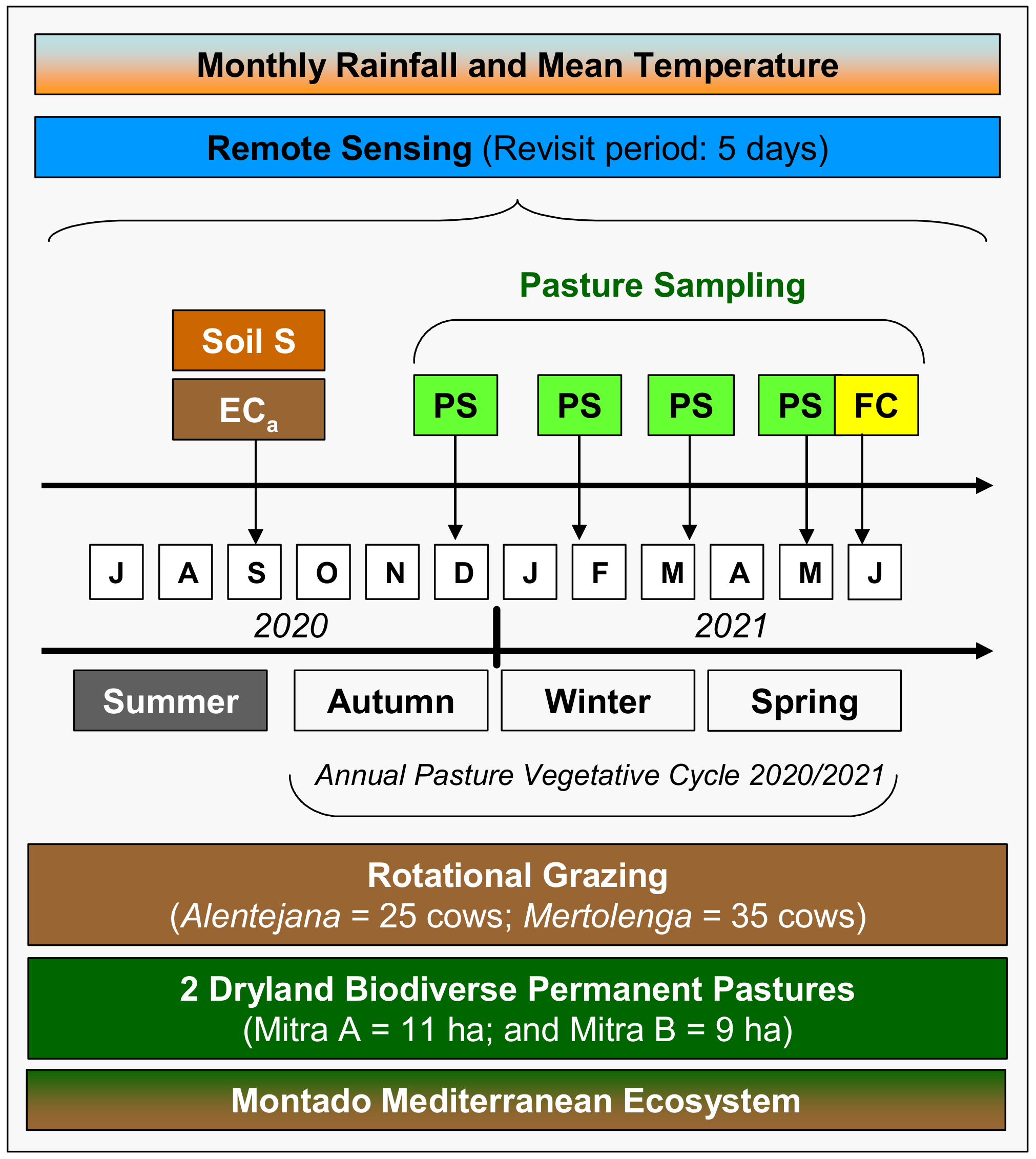

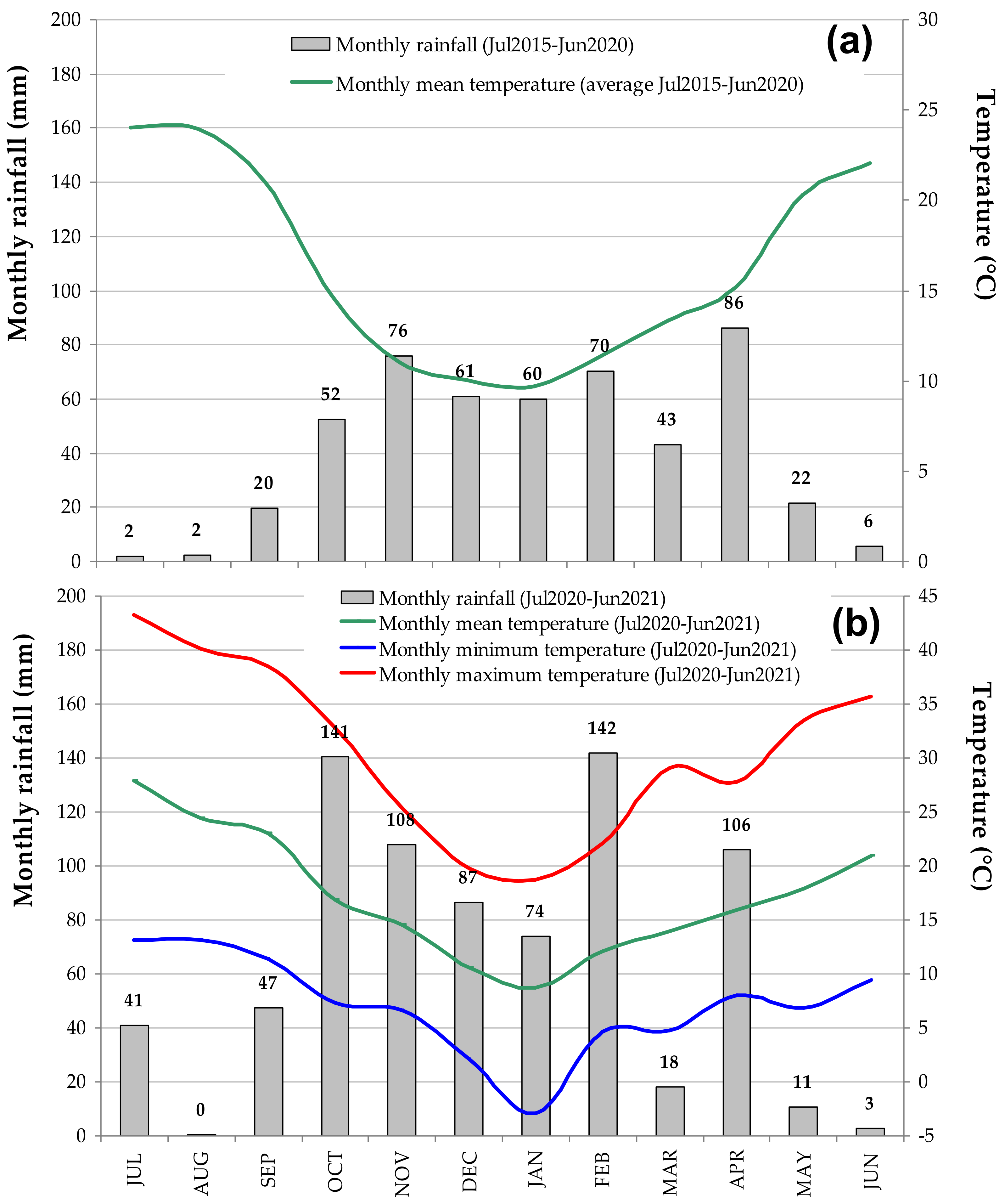
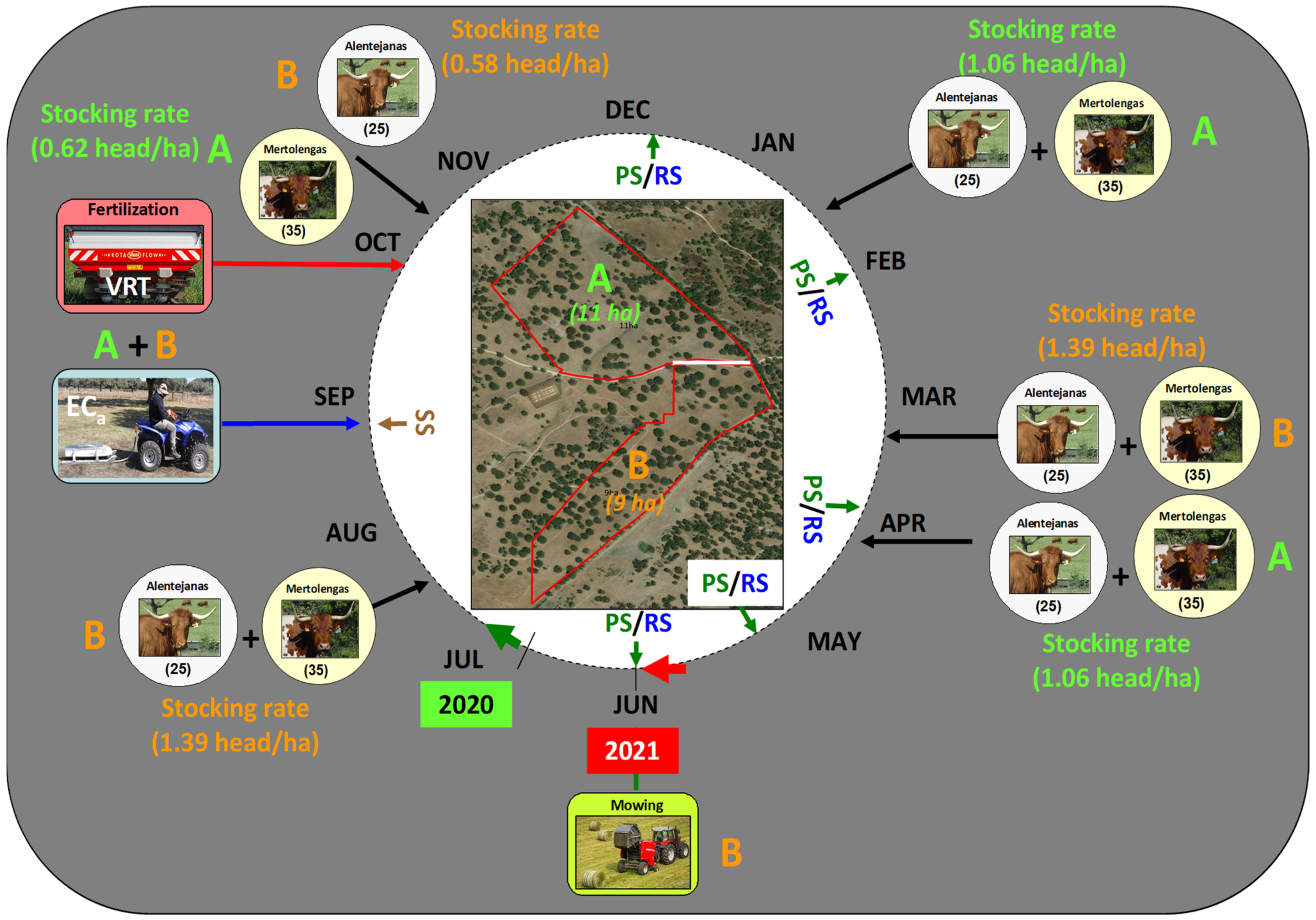
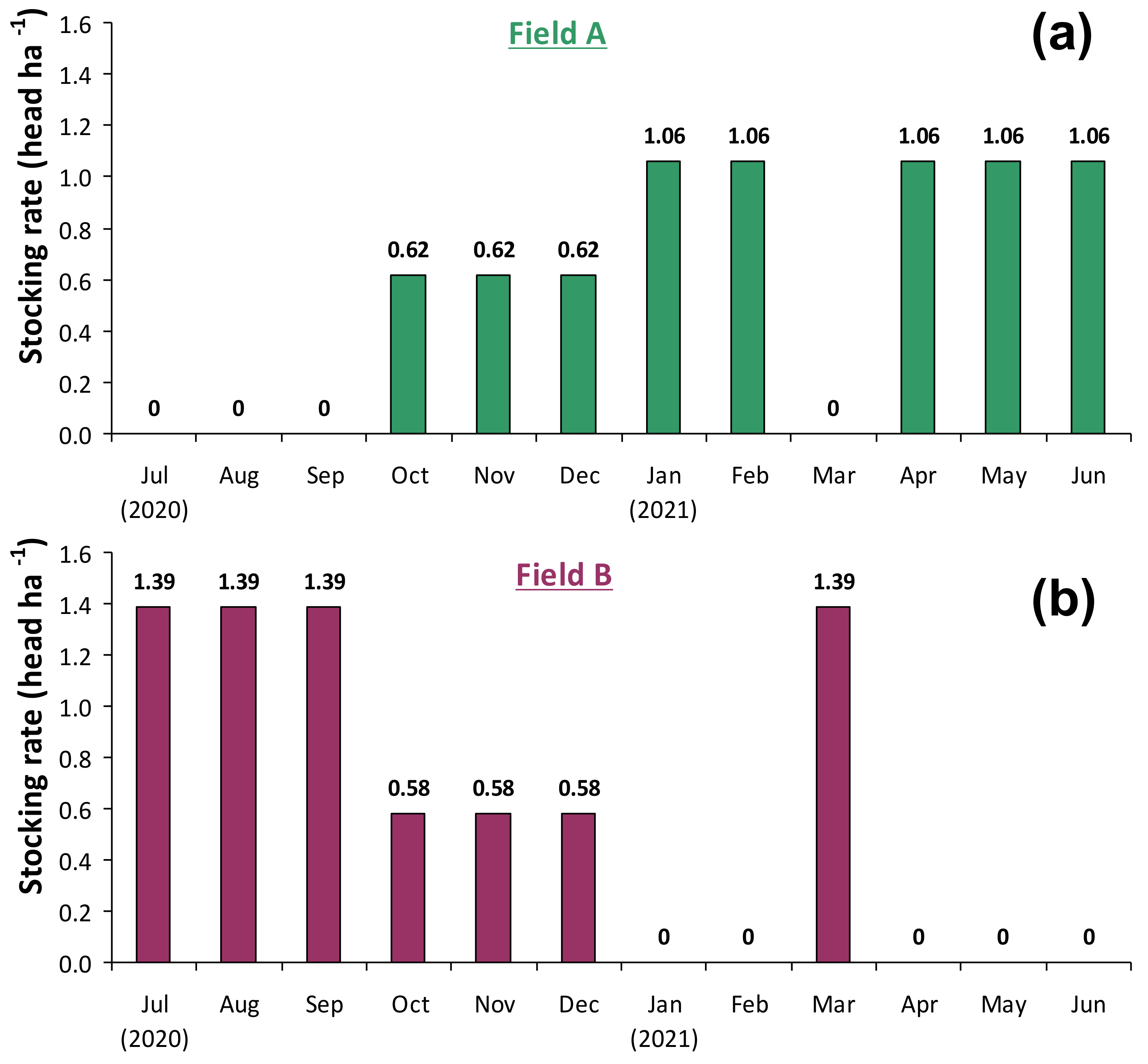

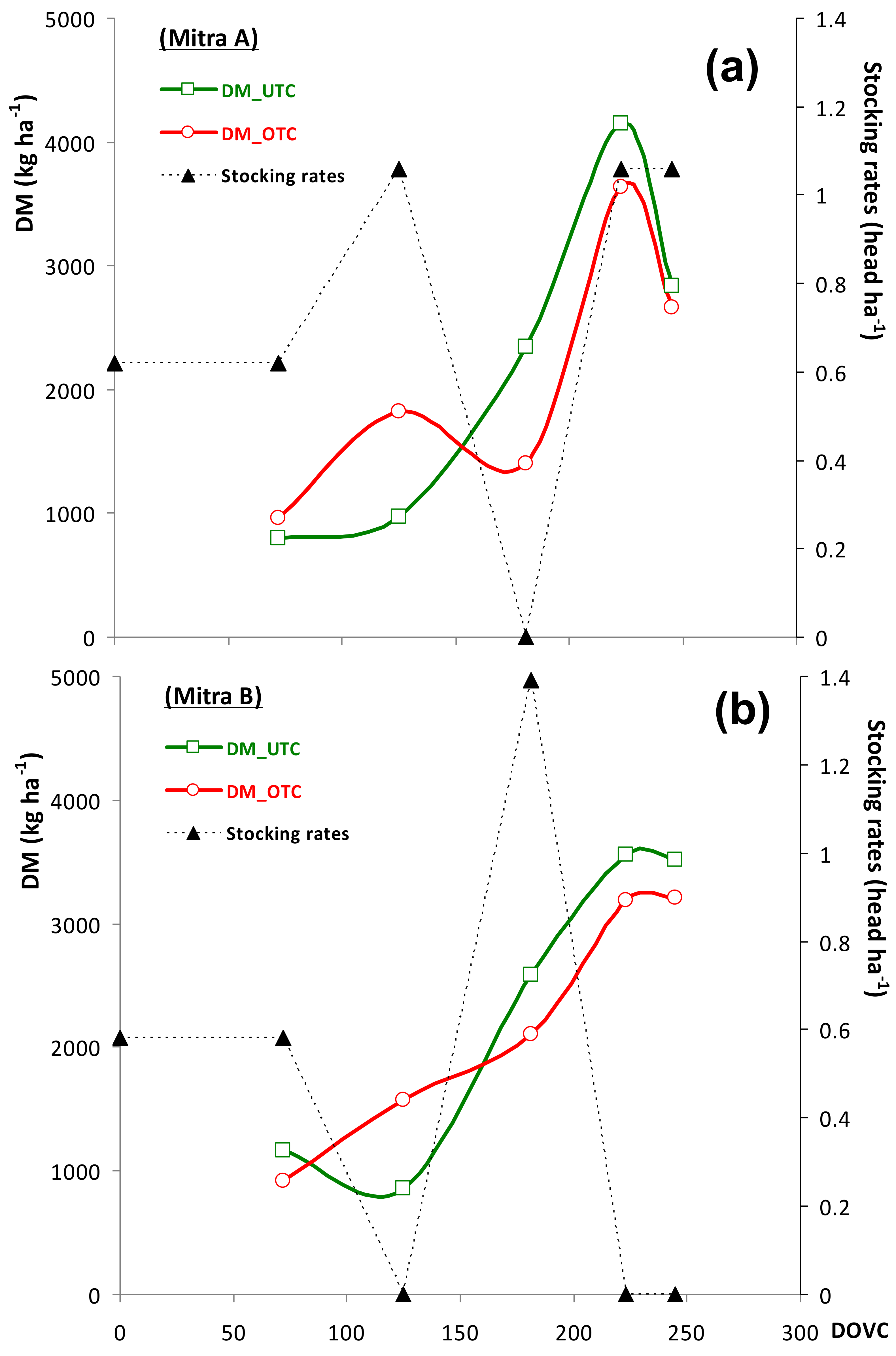
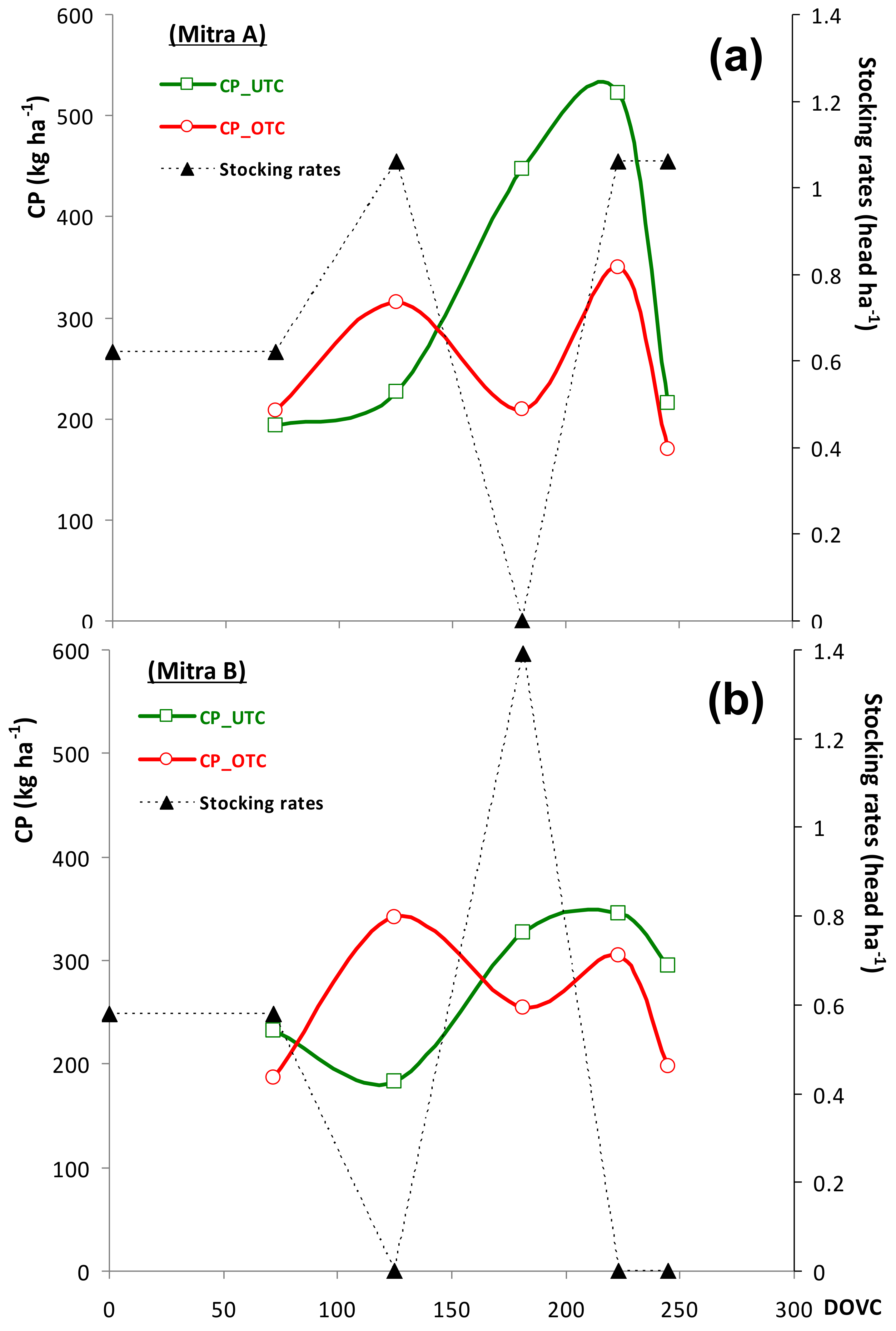
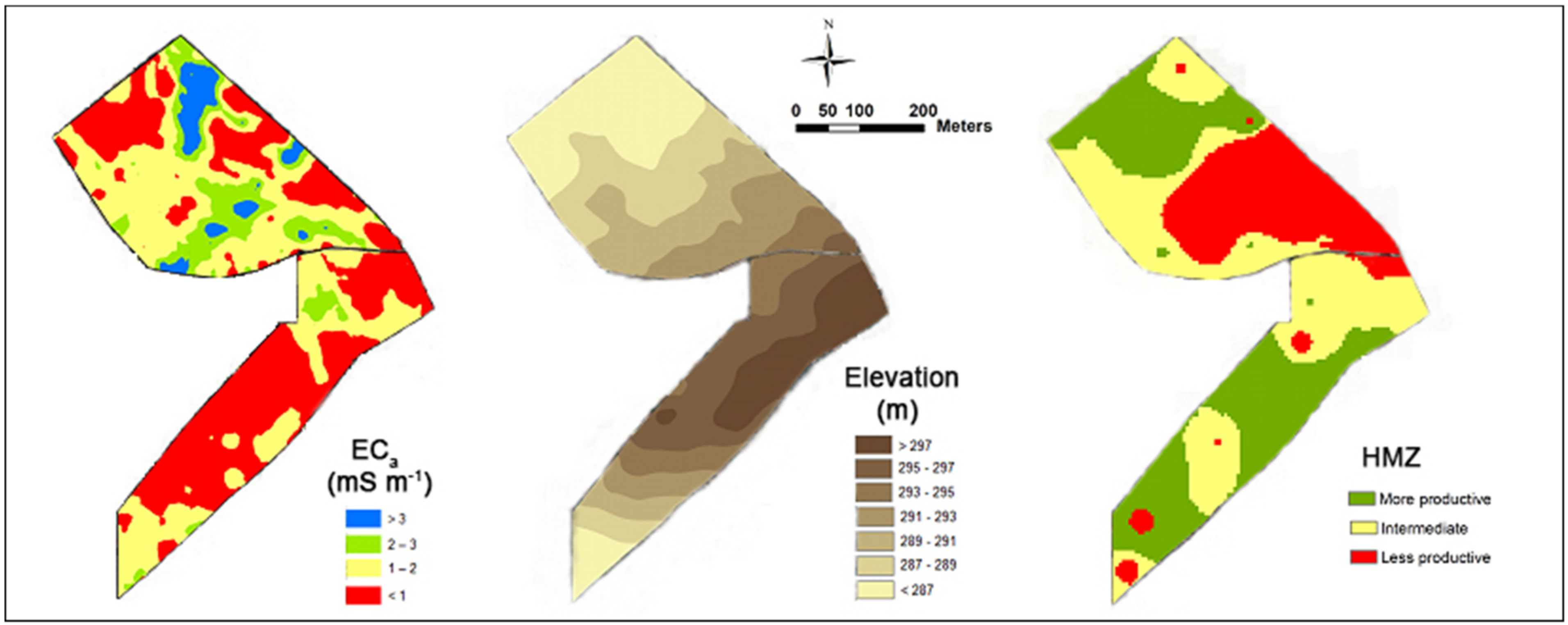


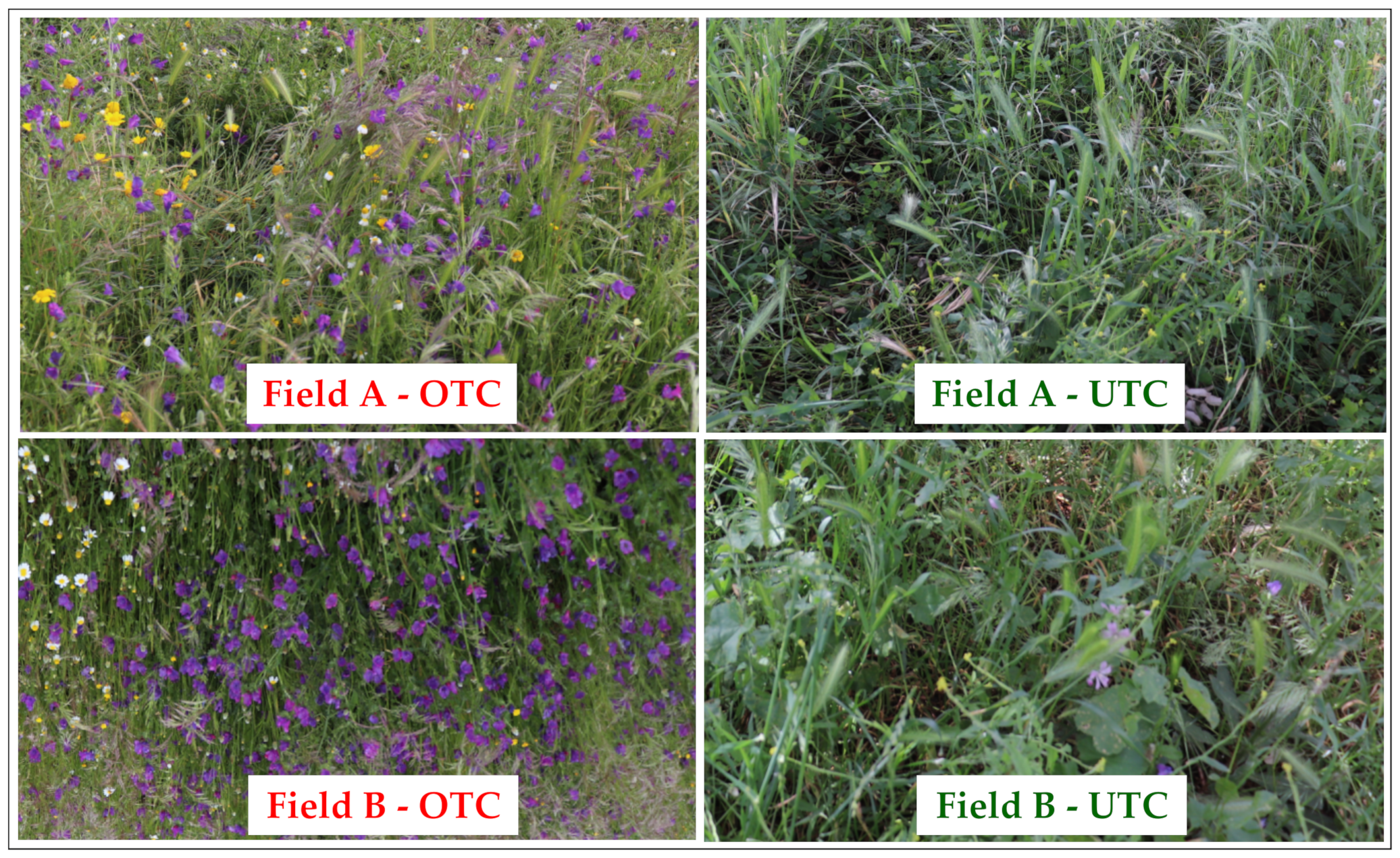
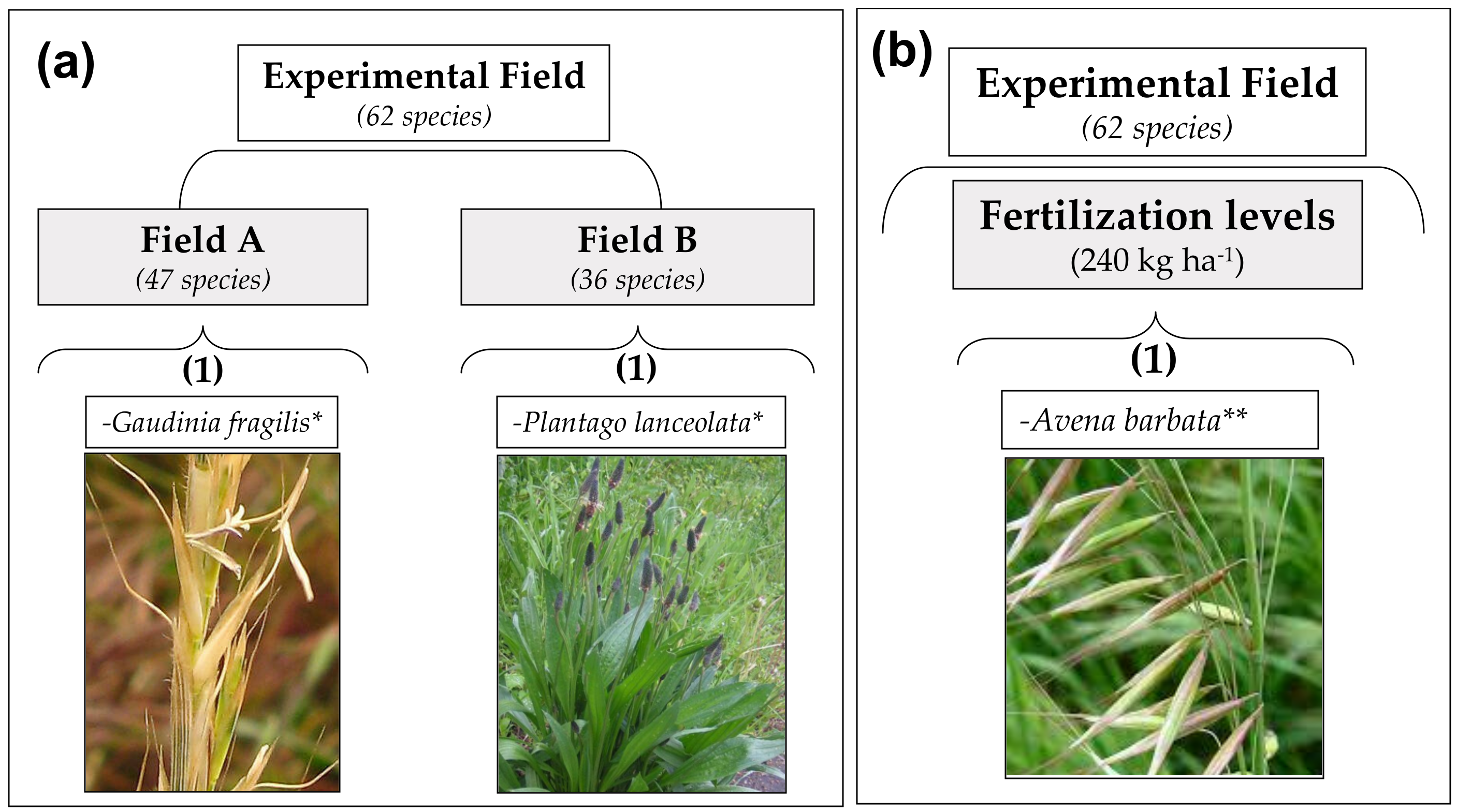
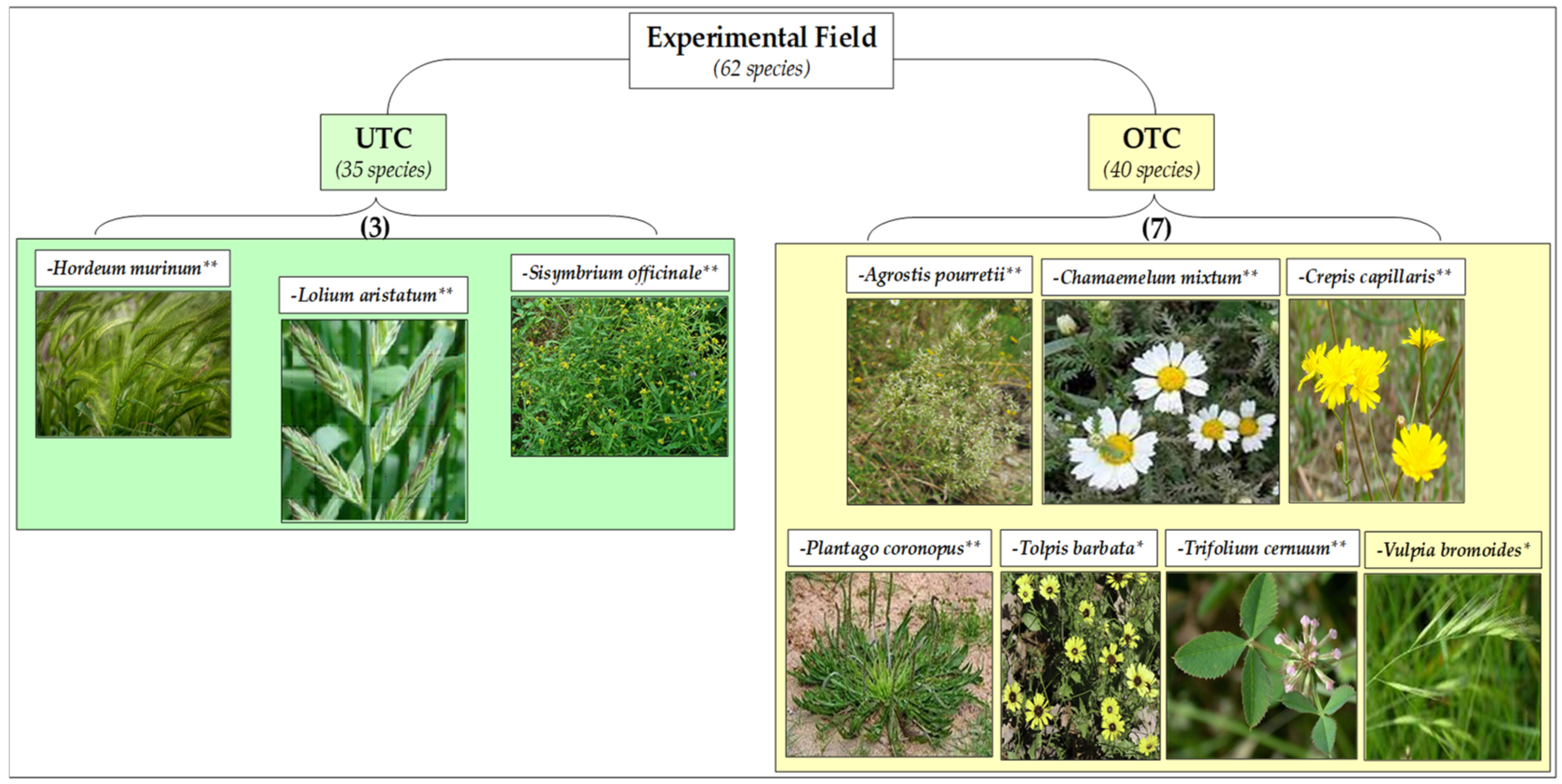
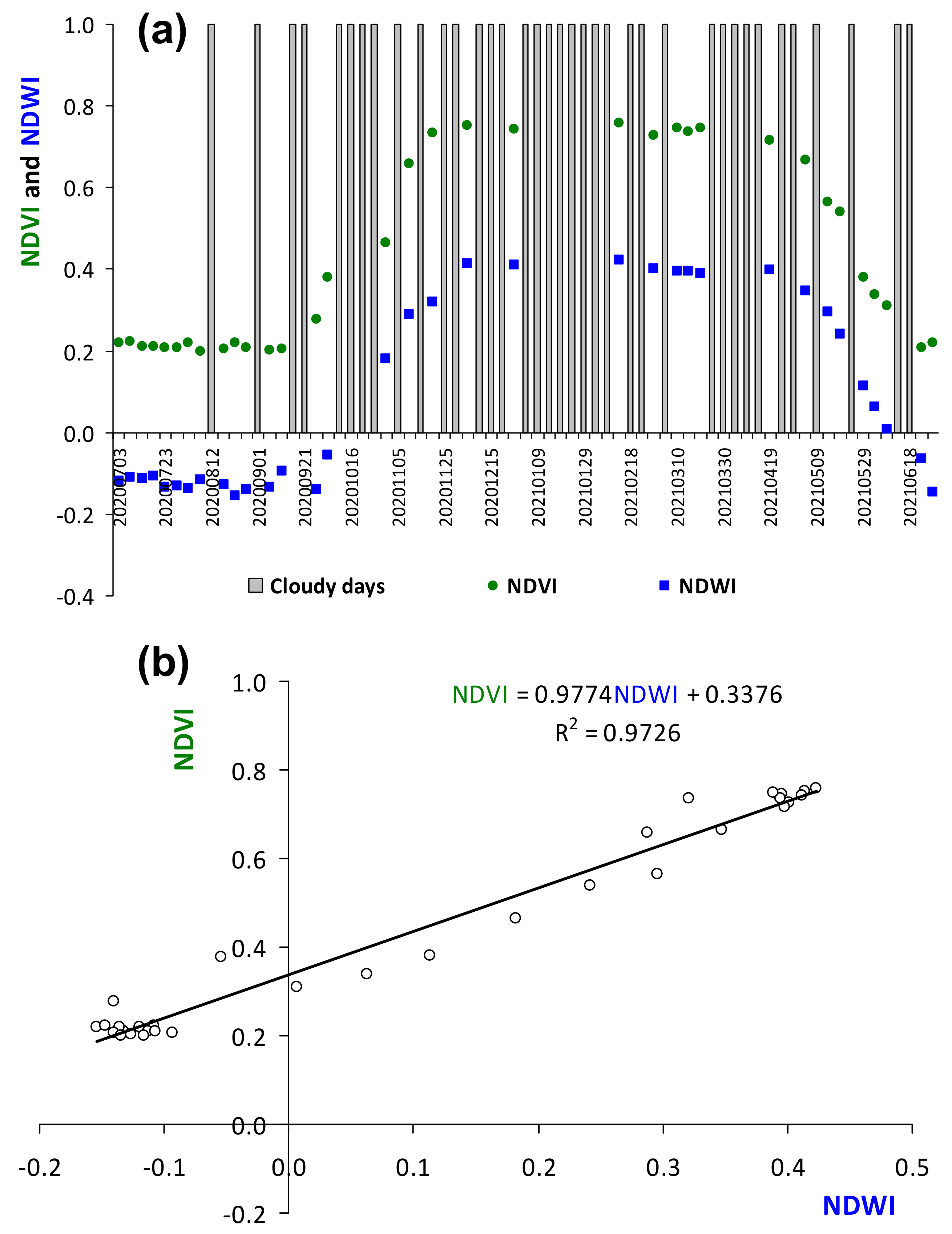
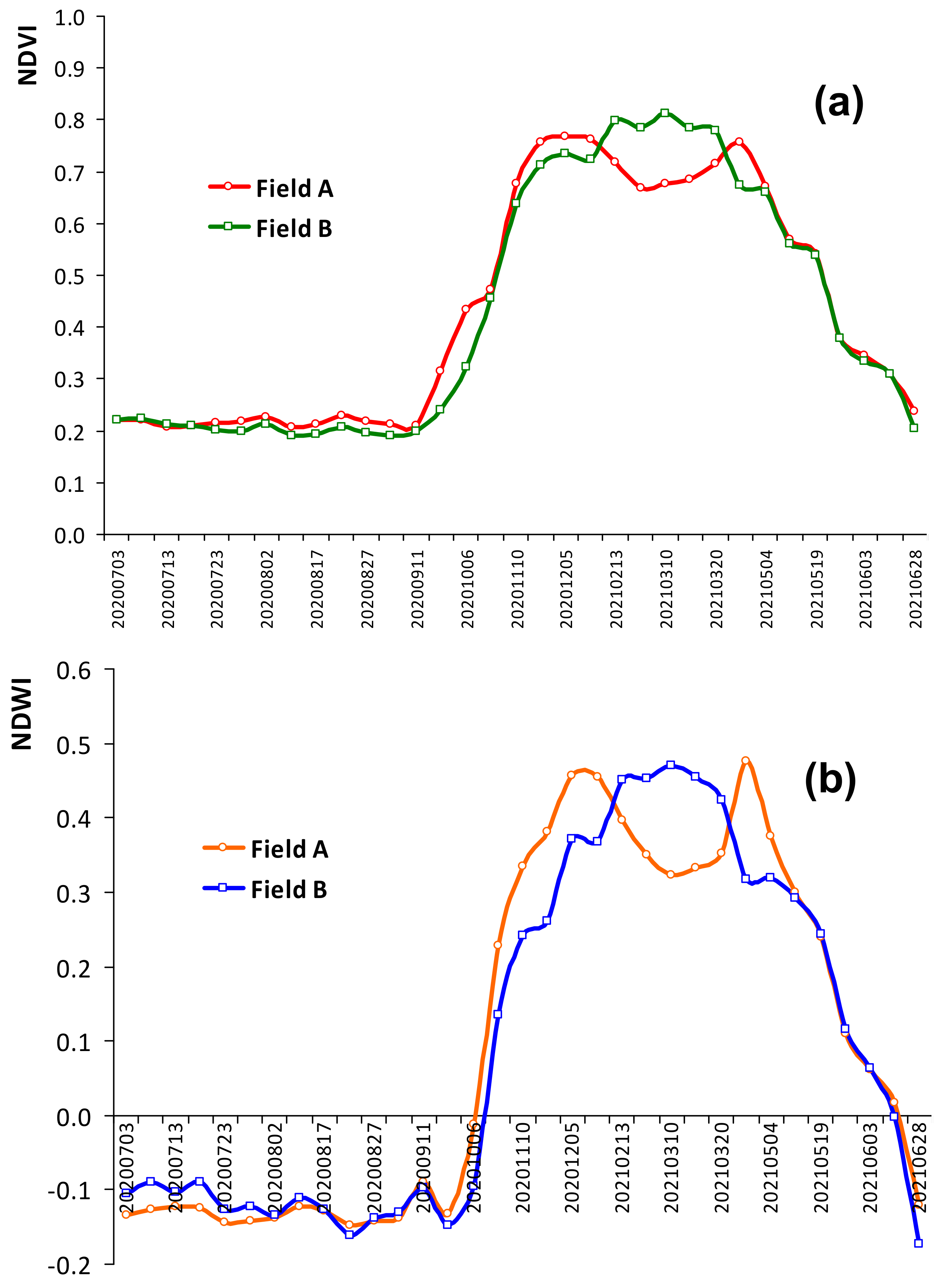
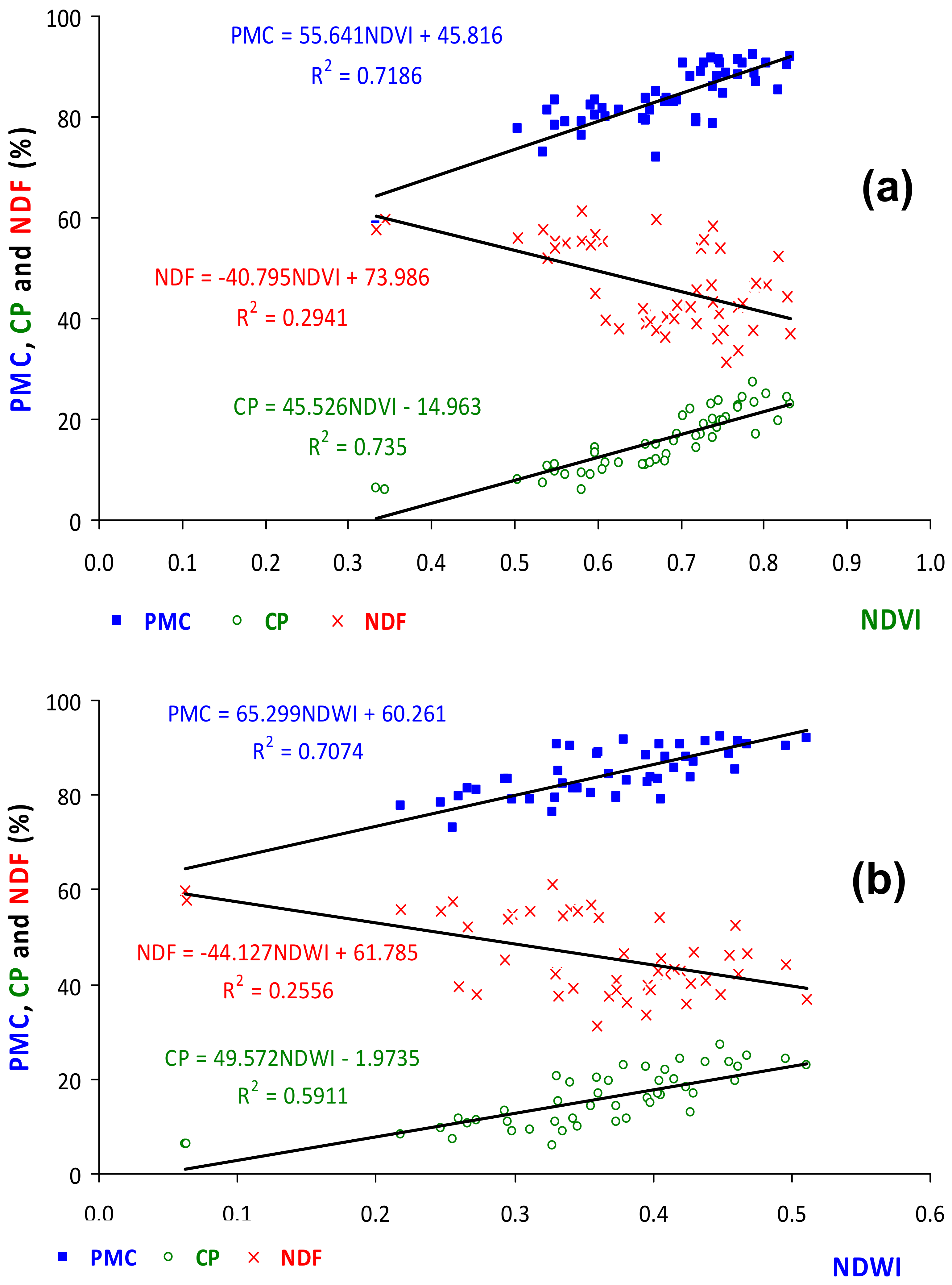
| Sampling Dates | Date of Pasture Sampling | Date of RS Capture * | Granule ** | Gap (Days) |
|---|---|---|---|---|
| Date 1 | 11 December 2020 | 5 December 2020 | L2A_T29SNC_A028491_20201205T112447 | −6 |
| Date 2 | 2 February 2021 | 13 February 2021 | L2A_T29SNC_A029492_20210213T112445 | +11 |
| Date 3 | 30 March 2021 | 4 April 2021 | L2A_T29SNC_A030207_20210404T112443 | +5 |
| Date 4 | 11 May 2021 | 14 May 2021 | L2A_T29SNC_A030779_20210514T112449 | +3 |
| Date 5 | 2 June 2021 | 3 June 2021 | L2A_T29SNC_A031065_20210603T112450 | +1 |
| UTC | OTC | |||||
|---|---|---|---|---|---|---|
| Parameter | Mean | CV | Range | Mean | CV | Range |
| Field A | ||||||
| Sand (%) | 81.4 | 3.6 | 76.2–87.1 | 82.6 | 4.4 | 77.6–85.4 |
| Silt (%) | 11.7 | 19.7 | 9.2–13.5 | 10.7 | 18.5 | 9.0–13.3 |
| Clay (%) | 6.9 | 39.1 | 3.8–8.9 | 6.7 | 42.7 | 3.2–9.2 |
| pH | 5.5 | 3.7 | 5.3–5.8 | 5.7 | 5.9 | 5.3–6.0 |
| OM (%) | 2.7 | 11.0 | 2.5–3.0 | 1.9 | 26.6 | 1.3–2.5 |
| P2O5 (mg kg−1) | 46.0 | 63.7 | 15–72 | 25.8 | 52.4 | 15–45 |
| K2O (mg kg−1) | 148.0 | 42.0 | 90–236 | 63.5 | 83.4 | 26–142 |
| CEC (cmol kg−1) | 12.3 | 48.0 | 8.0–21.0 | 10.3 | 70.3 | 5.8–21.2 |
| Field B | ||||||
| Sand (%) | 84.2 | 5.0 | 81.9–87.2 | 85.8 | 4.3 | 83.2–88.4 |
| Silt (%) | 7.7 | 19.5 | 6.7–8.2 | 7.2 | 17.7 | 6.3–8.1 |
| Clay (%) | 8.1 | 25.9 | 6.1–9.2 | 7.0 | 32.3 | 5.4–8.6 |
| pH | 6.0 | 2.4 | 5.9–6.1 | 5.4 | 2.6 | 5.3–5.5 |
| OM (%) | 2.3 | 11.4 | 2.1–2.5 | 1.8 | 14.9 | 1.7–2.0 |
| P2O5 (mg kg−1) | 39.5 | 19.7 | 34–45 | 28.0 | 60.6 | 16–40 |
| K2O (mg kg−1) | 146.0 | 3.9 | 142–150 | 72.0 | 23.6 | 60–84 |
| CEC (cmol kg−1) | 7.3 | 11.5 | 6.7–7.8 | 7.6 | 6.8 | 7.3–8.0 |
| UTC | OTC | |||||
|---|---|---|---|---|---|---|
| Parameter | Mean | CV | Range | Mean | CV | Range |
| Date 1 (11 December 2020) | ||||||
| Field A | ||||||
| DM (kg ha−1) | 798 | 36.7 | 430–1165 | 10110 | 40.4 | 4095–16,015 |
| PMC (%) | 91.0 | 3.1 | 86.6–94.4 | 89.0 | 6.0 | 78.6–92.4 |
| CP (%) | 24.3 | 21.8 | 17.8–31.0 | 21.9 | 17.8 | 16.4–27.2 |
| CP (kg ha−1) | 192.9 | 45.0 | 104.9–331.0 | 208.4 | 32.3 | 129.7–312.3 |
| NDF (%) | 39.2 | 17.0 | 31.2–47.2 | 42.0 | 19.7 | 35.9–58.2 |
| Field B | ||||||
| DM (kg ha−1) | 1162 | 33.5 | 725–1675 | 917 | 19.6 | 650–1120 |
| PMC (%) | 87.2 | 4.9 | 79.9–92.4 | 90.5 | 1.0 | 88.9–91.8 |
| CP (%) | 21.4 | 32.6 | 12.9–33.6 | 20.6 | 13.1 | 16.8–24.3 |
| CP (kg ha−1) | 231.9 | 21.8 | 181.3–320.4 | 187.3 | 20.7 | 148.5–246.8 |
| NDF (%) | 51.3 | 17.4 | 42.1–66.0 | 49.3 | 12.3 | 42.4–55.7 |
| Date 2 (2 February 2021) | ||||||
| Field A | ||||||
| DM (kg ha−1) | 975 | 28.6 | 655–1455 | 1821 | 26.3 | 1245–2680 |
| PMC (%) | 86.9 | 1.9 | 83.8–88.1 | 83.8 | 7.2 | 72.1–88.7 |
| CP (%) | 23.2 | 11.6 | 19.9–26.5 | 17.7 | 23.6 | 11.9–21.9 |
| CP (kg ha−1) | 226.8 | 30.6 | 140.1–332.1 | 315.0 | 24.3 | 201.4–392.4 |
| NDF (%) | 35.6 | 26.0 | 25.6–47.4 | 42.3 | 22.3 | 31.2–59.5 |
| Field B | ||||||
| DM (kg ha−1) | 857 | 14.3 | 700–1005 | 1576 | 12.7 | 1255–1825 |
| PMC (%) | 88.0 | 2.7 | 85.8–92.5 | 88.4 | 2.3 | 85.4–90.7 |
| CP (%) | 21.2 | 10.9 | 17.4–24.0 | 21.9 | 14.2 | 16.8–24.9 |
| CP (kg ha−1) | 182.6 | 19.3 | 122.0–217.7 | 342.2 | 13.6 | 274.5–409.4 |
| NDF (%) | 44.1 | 15.3 | 32.4–49.5 | 45.0 | 13.8 | 33.6–52.4 |
| Date 3 (30 March 2021) | ||||||
| Field A | ||||||
| DM (kg ha−1) | 2346 | 16.9 | 1680–2890 | 1407 | 11.9 | 1225–1710 |
| PMC (%) | 85.2 | 3.2 | 82.3–89.1 | 81.3 | 2.6 | 79.1–83.7 |
| CP (%) | 19.2 | 14.3 | 15.5–21.6 | 14.9 | 14.9 | 11.0–17.1 |
| CP (kg ha−1) | 447.5 | 19.7 | 331.4–531.5 | 209.4 | 15.9 | 147.5–243.6 |
| NDF (%) | 39.5 | 9.7 | 32.2–42.4 | 41.1 | 6.2 | 38.9–45.5 |
| Field B | ||||||
| DM (kg ha−1) | 2592 | 30.3 | 1695–4050 | 2108 | 38.7 | 1355–3625 |
| PMC (%) | 80.8 | 2.9 | 76.9–84.2 | 81.7 | 2.5 | 79.5–85.0 |
| CP (%) | 12.5 | 15.9 | 9.8–14.7 | 12.0 | 13.0 | 11.0–15.1 |
| CP (kg ha−1) | 327.5 | 38.5 | 198.1–553.8 | 254.5 | 41.8 | 152.1–417.7 |
| NDF (%) | 44.2 | 7.1 | 41.0–48.9 | 38.8 | 5.2 | 36.3–42.0 |
| Date 4 (11 May 2021) | ||||||
| Field A | ||||||
| DM (kg ha−1) | 4147 | 26.6 | 2835–6125 | 3638 | 18.4 | 3115–4890 |
| PMC (%) | 76.2 | 4.5 | 70.7–81.0 | 78.8 | 4.8 | 73.0–83.5 |
| CP (%) | 12.2 | 25.5 | 7.5–15.8 | 9.8 | 34.5 | 5.9–14.3 |
| CP (kg ha−1) | 522.1 | 47.9 | 274.6–949.6 | 350.0 | 34.3 | 238.9–552.9 |
| NDF (%) | 54.4 | 2.2 | 53.4–56.7 | 55.3 | 9.8 | 45.0–61.2 |
| Field B | ||||||
| DM (kg ha−1) | 3558 | 34.6 | 2240–5040 | 3190 | 37.2 | 2215–5215 |
| PMC (%) | 71.9 | 6.9 | 65.5–78.4 | 80.6 | 2.5 | 78.4–83.4 |
| CP (%) | 10.1 | 19.8 | 8.8–13.9 | 9.7 | 8.6 | 8.9–10.9 |
| CP (kg ha−1) | 346.1 | 25.1 | 247.3–462.7 | 304.8 | 32.3 | 202.3–471.1 |
| NDF (%) | 60.4 | 5.3 | 54.5–63.8 | 54.4 | 2.4 | 52.0–55.5 |
| Date 5 (2 June 2021) | ||||||
| Field A | ||||||
| DM (kg ha−1) | 2842 | - | - | 2660 | - | - |
| PMC (%) | 38.1 | - | - | 58.5 | - | - |
| CP (%) | 7.6 | - | - | 6.4 | - | - |
| CP (kg ha−1) | 215.7 | - | - | 170.2 | - | - |
| NDF (%) | 61.4 | - | - | 57.8 | - | - |
| Field B | ||||||
| DM (kg ha−1) | 3518 | - | - | 3212 | - | - |
| PMC (%) | 53.4 | - | - | 59.5 | - | - |
| CP (%) | 8.4 | - | - | 6.2 | - | - |
| CP (kg ha−1) | 294.5 | - | - | 197.7 | - | - |
| NDF (%) | 60.9 | - | - | 59.7 | - | - |
Publisher’s Note: MDPI stays neutral with regard to jurisdictional claims in published maps and institutional affiliations. |
© 2022 by the authors. Licensee MDPI, Basel, Switzerland. This article is an open access article distributed under the terms and conditions of the Creative Commons Attribution (CC BY) license (https://creativecommons.org/licenses/by/4.0/).
Share and Cite
Serrano, J.; Roma, L.; Shahidian, S.; Belo, A.D.F.; Carreira, E.; Paniagua, L.L.; Moral, F.; Paixão, L.; Marques da Silva, J. A Technological Approach to Support Extensive Livestock Management in the Portuguese Montado Ecosystem. Agronomy 2022, 12, 1212. https://doi.org/10.3390/agronomy12051212
Serrano J, Roma L, Shahidian S, Belo ADF, Carreira E, Paniagua LL, Moral F, Paixão L, Marques da Silva J. A Technological Approach to Support Extensive Livestock Management in the Portuguese Montado Ecosystem. Agronomy. 2022; 12(5):1212. https://doi.org/10.3390/agronomy12051212
Chicago/Turabian StyleSerrano, João, Luís Roma, Shakib Shahidian, Anabela D. F. Belo, Emanuel Carreira, Luís L. Paniagua, Francisco Moral, Luís Paixão, and José Marques da Silva. 2022. "A Technological Approach to Support Extensive Livestock Management in the Portuguese Montado Ecosystem" Agronomy 12, no. 5: 1212. https://doi.org/10.3390/agronomy12051212
APA StyleSerrano, J., Roma, L., Shahidian, S., Belo, A. D. F., Carreira, E., Paniagua, L. L., Moral, F., Paixão, L., & Marques da Silva, J. (2022). A Technological Approach to Support Extensive Livestock Management in the Portuguese Montado Ecosystem. Agronomy, 12(5), 1212. https://doi.org/10.3390/agronomy12051212









